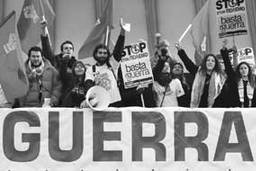The single most dramatic moment of the protests in Quebec came on the first day of the summit, when the thousands of protesters who had marched through the city finally reached “the wall.” Until that point no one had seen a single cop. Now, a phalanx of riot police, armed to the teeth with tear gas, pepper bombs and plastic bullets, waited silently behind the chain-link fence. There was a momentary pause, and then hundreds of masked activists – ranging from black-clad anarchists to Mohawk Warriors – descended on the wall itself, produced grappling hooks and wire cutters, and began to systematically tear it down.
This was not simply a fortuitous target of opportunity: a month before, a call had gone out over the Internet – put out by anarchists and members of the newly formed American branch of Ya Basta!, originally an Italian group, which has been calling for principles of free immigration and global citizenship – for “all people held back by walls to converge in Quebec City to take direct action against the security perimeter.”
Attacks on the wall were echoed by actions against border posts across North America. In Vermont, there were “people’s assemblies” along the border at spots where the Canadian government was systematically denying entry to anyone who so much as looked like an activist. Several hundred activists occupied the Peace Bridge in Buffalo; thousands rallied on both sides of the crossing between San Diego and Tijuana; in Blaine, Washington, 4,000 activists and union members from the United States and Canada marched across a border bridge and seized customs posts before finally being dislodged by the Royal Canadian Mounted Police.
Walls and borders were the perfect symbols: Treaties like the FTAA allegedly promote a process that is making nation-states and national borders increasingly irrelevant. The reality is that corporate globalization is premised on exactly the opposite of a free flow of people, products and ideas. Rather it is based on keeping the majority of the world’s population trapped behind increasingly fortified borders, within which even existing social services can be withdrawn, and then removing all restrictions which might have kept Nike and The Gap from taking full advantage of their resultant desperation.
In fact, the size of the U.S. Border Patrol has almost tripled since the signing of NAFTA, and the Immigration and Naturalization Service (along with police forces and prisons) is about the only branch of government that is actually growing. By fortifying the border and placing dozens of activists in arbitrary detention to prevent them from being able to express their ideas in Quebec, the Canadian government was merely subjecting mostly white activists to the sort of violence most of the world’s population face every day.
More than anything, the attacks on walls and borders demonstrated that the rapidly growing movement of global resistance is not an “anti-globalization movement” at all. It is, or is rapidly becoming, a movement for real globalization, for the genuine free movement of people, possessions and ideas.
It is not clear whether the movement will ever be able to get this point across to the corporate media. When it comes to the free flow of ideas at least, the corporate media constitutes the greatest wall of all (and indeed, activists are increasingly debating whether the next step is direct action against the media). But with so many unions rapidly switching their positions from nationalistic nativism to actual support for increased immigration and amnesty for undocumented workers, we might well be seeing the beginnings of an historic transformation.







